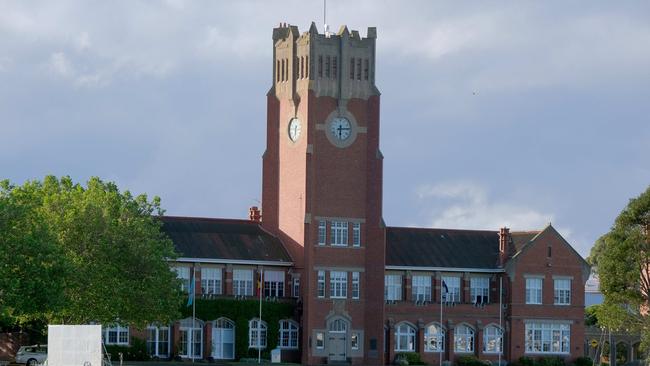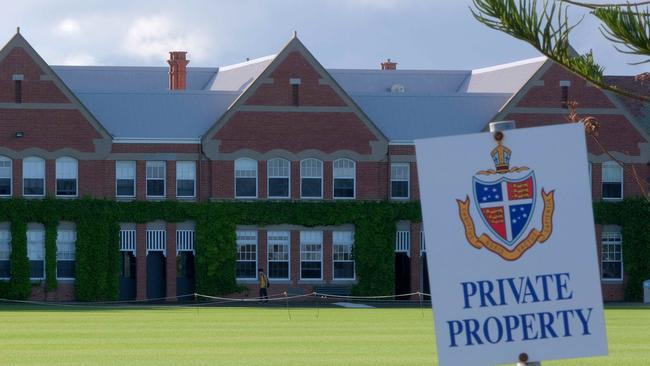Geelong Grammar using fingerprint tech to track students
Geelong Grammar has given the thumbs up to Big Brother-inspired technology that will keep tabs on up to 600 students at its Corio campus. This is how it works and what it might mean for more Victorian schools.

World-renowned Geelong Grammar plans to track the movements of students at its Corio campus using thumb print technology.
The co-ed school has signed up for the REACH biometric package, which is aimed at cutting paperwork, increasing efficiency and improving communication.
It has told parents it plans to roll out the digital technology house by house in coming months, saying it will provide clarity around student movement and greater confidence in the school’s duty of care obligations.
It will involve the use of a BioPad which will use biometric data in the form a student’s thumbprint to verify the student’s identify when they are checking in and out of their house.
Students will check in via kiosks around the school.
It will cover 600 students, who are primarily boarders, and those attending as day students.

Under the proposal, day students will have to check into their house at the start of the day and check out at the end of the day.
The news of Geelong Grammar embracing tracking technology comes after Melbourne start up LoopLearn was left reeling this time last year when news of trials of it facial technology caused a backlash.
LoopLearn was planning to trial the technology at a range of government and non-government schools but Education Minister James Merlino hit the roof, saying it would not be allowed in government schools.
In the meantime, LoopLearn, which scored a $470,000 grant to commercialise its product is quietly going about signing up schools to trial its product.
Its director Zoe Milne, wounded by the furore, does not want to speak publicly but she has insisted the technology is safe and once people are briefed about how it works any fears are allayed.
Like REACH, LoopLearn converts biometric image data into a string of numbers to ensure privacy and security. This means no images are ever saved, only a string of numbers that cannot be reverse engineered into an image and are meaningless to anything but the software they were made for.
The REACH students’ management system can be accessed via the desktop or mobile app.
A parent or student applies for leave and those who need to know are informed. Relevant people are notified or emailed. They can then approve the leave. There is an option to seek more information or deny the leave. The approval will appear on a student movement screen.
Head of campus for Corio Steven Church notified families of the plan early in January.
“REACH will manage leave and exeats in all houses at the Corio campus. For both senior and middle school and across boarding and day houses. REACH will be implemented in a staged manner and you will receive further detailed information in advance of your child’s house commencing the use of REACH,” Mr Church wrote.
Mr Church told parents the collection, storage and use of student biometric data to support the leave and exeat program was provided for in the school’s condition of entry.
He allayed any fears about privacy, saying the information collected by REACH would be stored by REACH and only used by them.
“The biometric information is being stored as a mathematical algorithm of your child’s fingerprint and is not the actual fingerprint image itself,” he told parents.
“The algorithm is readable only by REACH.
“Biometrics provide the most secure and accurate authentication method for identification verification.”
MORE EDUCATION:
TOP SCHOOL FLAGS STUDENT GENDER SWAPS
WHY TOP SCHOOL AXED YEAR 12 FORMAL
Mr Church assured parents that the thumbprint would not be used outside of the school.
He also moved to allay any fears around safety.
“A thumbprint is unique. No two people have identical thumbprints. It would be next to impossible for someone to steal someone else’s biometric (thumb print) and the thumbprint itself is not stored by REACH, only an encrypted interpretation of the thumbprint image”.
It is unclear what other schools in Victoria who have signed up for REACH.
But MLC, in Claremont in Western Australia, has vouched for the product in an online testimonial on the REACH website.
Its boarding manager said chasing paperwork for 86 boarders was a pain point in her job.
According to REACH, there are 350 schools using the technology in five continents.
REACH said it was unable to comment on the schools using the technology. Geelong Grammar did not return calls and emails.
